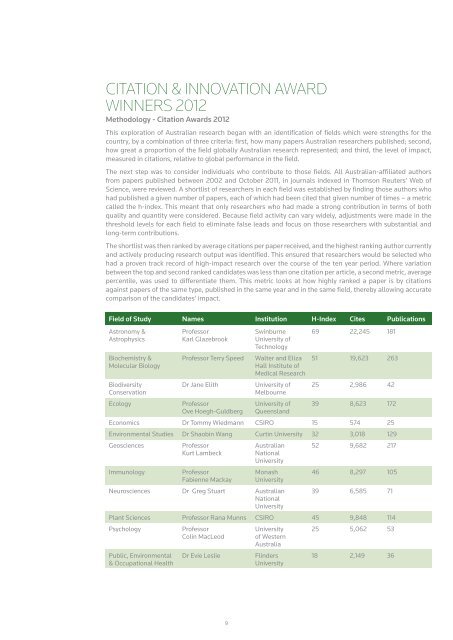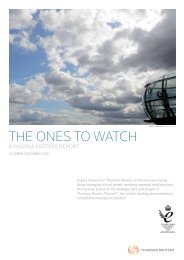2012 thomson reuters australia citation & innovation awards
2012 thomson reuters australia citation & innovation awards
2012 thomson reuters australia citation & innovation awards
You also want an ePaper? Increase the reach of your titles
YUMPU automatically turns print PDFs into web optimized ePapers that Google loves.
CITATION & INNOVATION AWARD<br />
WINNERS <strong>2012</strong><br />
Methodology - Citation Awards <strong>2012</strong><br />
This exploration of Australian research began with an identification of fields which were strengths for the<br />
country, by a combination of three criteria: first, how many papers Australian researchers published; second,<br />
how great a proportion of the field globally Australian research represented; and third, the level of impact,<br />
measured in <strong>citation</strong>s, relative to global performance in the field.<br />
The next step was to consider individuals who contribute to those fields. All Australian-affiliated authors<br />
from papers published between 2002 and October 2011, in journals indexed in Thomson Reuters’ Web of<br />
Science, were reviewed. A shortlist of researchers in each field was established by finding those authors who<br />
had published a given number of papers, each of which had been cited that given number of times – a metric<br />
called the h-index. This meant that only researchers who had made a strong contribution in terms of both<br />
quality and quantity were considered. Because field activity can vary widely, adjustments were made in the<br />
threshold levels for each field to eliminate false leads and focus on those researchers with substantial and<br />
long-term contributions.<br />
The shortlist was then ranked by average <strong>citation</strong>s per paper received, and the highest ranking author currently<br />
and actively producing research output was identified. This ensured that researchers would be selected who<br />
had a proven track record of high-impact research over the course of the ten year period. Where variation<br />
between the top and second ranked candidates was less than one <strong>citation</strong> per article, a second metric, average<br />
percentile, was used to differentiate them. This metric looks at how highly ranked a paper is by <strong>citation</strong>s<br />
against papers of the same type, published in the same year and in the same field, thereby allowing accurate<br />
comparison of the candidates’ impact.<br />
Field of Study Names Institution H-Index Cites Publications<br />
Astronomy &<br />
Astrophysics<br />
Biochemistry &<br />
Molecular Biology<br />
Biodiversity<br />
Conservation<br />
Professor<br />
Karl Glazebrook<br />
9<br />
Swinburne<br />
University of<br />
Technology<br />
Professor Terry Speed Walter and Eliza<br />
Hall Institute of<br />
Medical Research<br />
Dr Jane Elith University of<br />
Melbourne<br />
Ecology Professor<br />
Ove Hoegh-Guldberg<br />
University of<br />
Queensland<br />
69 22,245 181<br />
51 19,623 263<br />
25 2,986 42<br />
39 8,623 172<br />
Economics Dr Tommy Wiedmann CSIRO 15 574 25<br />
Environmental Studies Dr Shaobin Wang Curtin University 32 3,018 129<br />
Geosciences Professor<br />
Kurt Lambeck<br />
Immunology Professor<br />
Fabienne Mackay<br />
Australian<br />
National<br />
University<br />
Monash<br />
University<br />
Neurosciences Dr Greg Stuart Australian<br />
National<br />
University<br />
52 9,682 217<br />
46 8,297 105<br />
39 6,585 71<br />
Plant Sciences Professor Rana Munns CSIRO 45 9,848 114<br />
Psychology Professor<br />
Colin MacLeod<br />
Public, Environmental<br />
& Occupational Health<br />
University<br />
of Western<br />
Australia<br />
Dr Evie Leslie Flinders<br />
University<br />
25 5,062 53<br />
18 2,149 36





